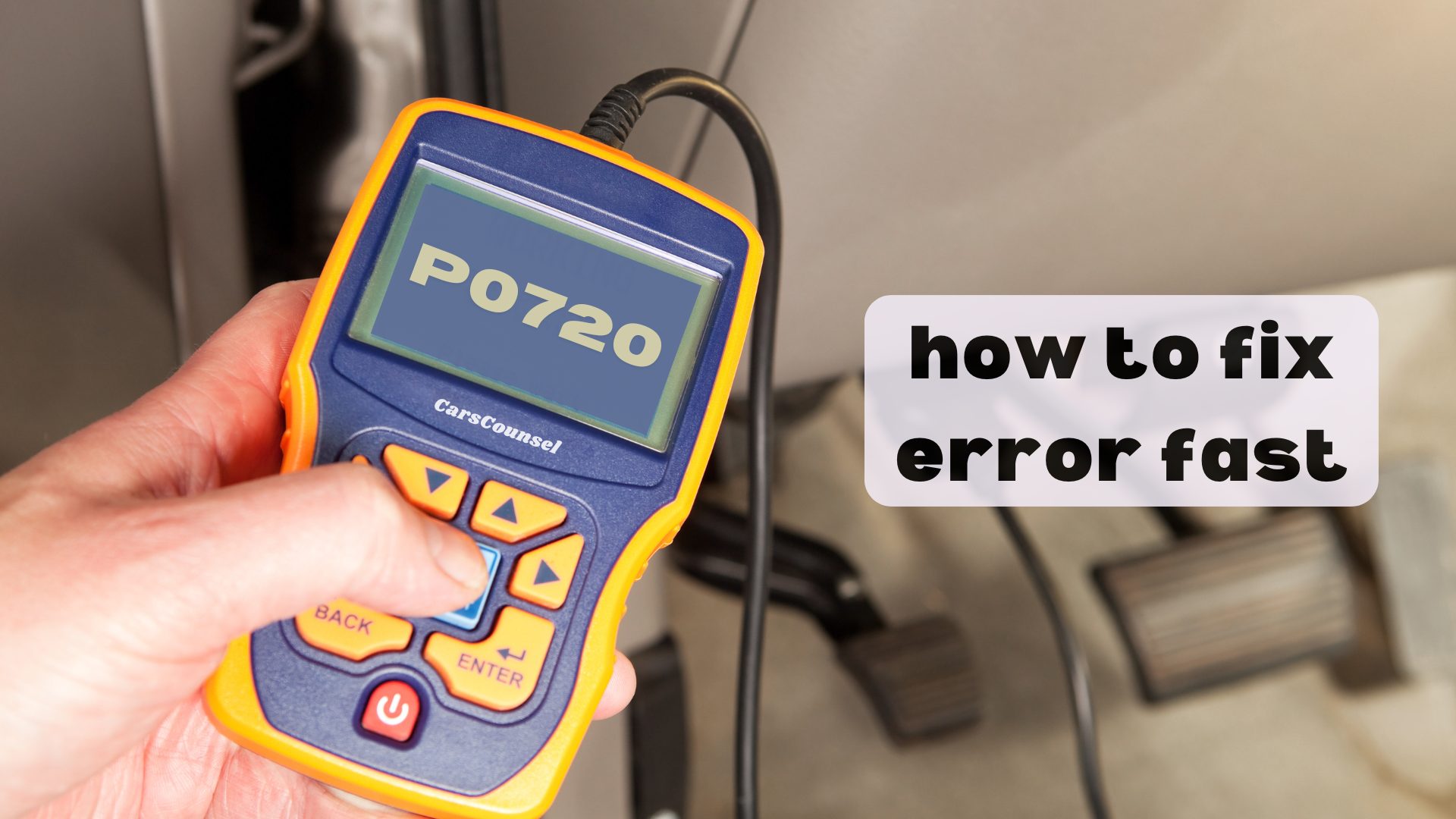If you’ve come across the P0720 code on your vehicle, you’re probably eager to fix this transmission issue quickly.
Start by using an OBD-II scanner to identify the exact problem and confirm the error of OBD2 Codes.
Next, check the output speed sensor for any damage, inspect all the wiring and connections, and look at the condition of the transmission fluid.
But what if the problem continues? Knowing why this code is important and how to properly diagnose it can save you both time and money.
Let’s go through each step to help get your vehicle running smoothly again.

Quick Navigation
Key Takeaways
- Swap out the faulty output speed sensor to fix the P0720 code.
- Check and fix any damaged or loose wires and connections linked to the sensor.
- Make sure the transmission fluid is clean and at the right level to help the sensor work properly.
- Use an OBD-II scanner to clear the code and check if the fix worked.
What Is P0720 Code?
The P0720 code means there’s a problem with your car’s output speed sensor circuit, which is important for tracking how fast the transmission’s output shaft is spinning.
When this code pops up, it means the sensor isn’t giving the right data, which can mess up how the transmission works. This can lead to issues like erratic shifting, bad fuel efficiency, and even possible transmission damage.
To fix the P0720 code, start by checking if the output speed sensor is damaged or dirty. Look at the wiring and connections for any signs of wear or rust.
You can use an OBD-II scanner to find and clear the code after making repairs. Knowing these steps will help you fix the problem quickly, so your car runs smoothly and efficiently.
Why P0720 Matters
Fixing the P0720 code quickly is crucial because it affects how well your car’s transmission works and keeps you safe.
Understanding what this code means can help you see why it’s important. The P0720 code shows there’s a problem with the output speed sensor circuit, which can cause your transmission to act weird.
Taking care of this issue early on can save you from big, expensive repairs. Ignoring the P0720 code not only makes your car less efficient but also makes driving dangerous because it can create unpredictable situations.
Regular check-ups are needed to spot and fix this code, making sure your car stays dependable and safe on the road.
Key Symptoms of P0720
If your speedometer is acting up and your car’s transmission is shifting strangely, you might be dealing with a P0720 code. This code means the output speed sensor isn’t giving accurate readings to the transmission control module.
As a result, you might see your speedometer jumping around, making it hard to tell how fast you’re going. Your transmission might also shift late or harshly. The Check Engine Light (CEL) will probably come on to let you know there’s a problem.
You might also notice that your fuel efficiency is worse because the car can’t shift gears properly. Fixing these issues quickly can help avoid more damage and keep your car running smoothly.
Common Causes of P0720
To figure out what’s causing a P0720 code, you should look at a few common issues.
First, check if the output speed sensor is broken or not working properly.
Next, inspect the wiring and connections for any damage or loose parts, as these can mess up the signal between the sensor and the engine control unit (ECU).
Also, make sure the transmission fluid isn’t low or dirty, because that can affect how the sensor works.
Sometimes, the ECU itself might be the problem, not reading the sensor data correctly.
Fixing these problems quickly can prevent more serious damage and keep your car running smoothly.
Diagnosing P0720 Code
To diagnose a P0720 code, start by using an OBD-II scanner to get the fault code.
Then, visually inspect the output speed sensor for any damage or wear. Make sure the sensor is calibrated properly and check for any loose or corroded connections.
Here are the tools and steps you’ll need:
- OBD-II scanner: To retrieve and clear fault codes.
- Multimeter: To test the sensor and wiring for continuity.
- Inspection tools: To visually check the sensor and connections.
- Wiring diagrams: To verify the wiring paths are correct.
Checking the Speed Sensor
Start by finding the output speed sensor on your vehicle’s transmission. This is the first step in checking for any issues.
Keeping your speed sensor in good shape is crucial to fix the P0720 code. Look at your vehicle’s manual to see exactly where the sensor is.
Once you find it, check for any damage or wear. Use a multimeter to test the sensor’s voltage and resistance based on your vehicle’s specs.
These tests will show if the sensor is working right. If the readings are off, you might need to replace the sensor.
Keeping your speed sensor in good condition helps your vehicle run smoothly and avoids future problems.
Inspecting Wiring and Connections
After checking the speed sensor, take a close look at the wiring and connections for any signs of wear, damage, or corrosion. Start by ensuring the wires and connections are in good shape because they’re crucial for accurate sensor readings. Carefully check the harness that goes to the speed sensor and the ECU.
- Look for frayed or broken wires: Exposed wires can disrupt signals.
- Check for loose or disconnected plugs: These can cause the signal to fail sometimes.
- Inspect for signs of rust or corrosion: Corrosion can block electrical flow.
- Make sure connections are secure: Ensure all connectors are tightly in place.
Evaluating Transmission Fluid
When checking the transmission fluid, make sure the car is on flat ground and the engine is warm for an accurate reading.
First, find the transmission dipstick, usually located in the engine bay. Pull it out, wipe it clean, put it back in, and then pull it out again to check the fluid level. The fluid should be within the recommended range on the dipstick.
Next, take a look at the fluid’s color and consistency. Good fluid is usually bright red and clear. If it’s dark, dirty, or smells burnt, it means the fluid is bad.
Changing or adding fluid quickly can prevent problems and keep your transmission working well.
Repair and Replacement Solutions
Repair and Replacement Solutions
To fix the P0720 code, start by replacing the output shaft speed sensor, which is usually the main problem. Make sure to use a good-quality replacement part to avoid future issues.
Next, focus on taking care of the sensor and the transmission to keep your vehicle in top shape.
- Look for and fix any damaged wiring or connections: Make sure all connections are tight and free from rust.
- Check and replace transmission fluid: Ensure the fluid is at the right level and clean.
- Test the transmission control module (TCM): Replace it if it’s not working properly.
- Do a final test drive: Make sure the problem is fixed and the transmission works smoothly.
Preventing Future P0720 Issues
To avoid P0720 problems in the future, it’s important to keep up with regular maintenance and check-ups for your car’s sensors and transmission system.
Start by regularly inspecting the output speed sensor and its connections for any signs of wear or rust.
Make sure your transmission fluid is clean and at the right level to keep the sensor working well.
Use an OBD-II scanner for regular diagnostics to catch any potential issues early.
Pay attention to the Check Engine Light and deal with any problems right away.
By following these simple steps, you can prevent the P0720 code from coming back and ensure your car stays safe and reliable on the road.
Regular maintenance isn’t just a good idea—it’s essential.
More OBD-II Codes
Frequently Asked Questions
Can Driving With a P0720 Code Damage My Transmission?
Yes, driving with a P0720 code can damage your transmission. Use diagnostic tools to find the problem. Fix it quickly to avoid serious damage and keep your car running smoothly. Regular checks can help you avoid expensive repairs.
How Much Does It Typically Cost to Fix a P0720 Code?
Fixing a P0720 code can be unpredictable. It usually costs between $150 and $400, including diagnostic fees. The price depends on whether you need to replace the sensor, wiring, or transmission control module.
How Often Should I Check My Vehicle for OBD-II Codes?
You should check your vehicle for OBD-II codes at least once a month. Regularly scanning for these codes helps you spot problems early, making it easier to keep up with maintenance, avoid expensive repairs, and ensure your car runs smoothly and safely.
Are There Specific Models More Prone to P0720 Issues?
Think of your car’s transmission sensors like the brain’s neurons. Some common models that often have P0720 issues are Ford, Nissan, and Honda. Their transmission sensors can sometimes send mixed signals, causing the error. Regular check-ups can help keep your car running smoothly.
Can a DIY Repair Resolve a P0720 Code Reliably?
Yes, you can fix a P0720 code yourself. Start by testing the output speed sensor and checking the wiring. If needed, replace the sensor. Make sure you have the right tools and follow detailed repair guides.
Conclusion
In short, fixing the P0720 code quickly is crucial for a smooth drive.
Start by scanning for errors and confirming the problem.
Check the output speed sensor, wiring, and transmission fluid.
If the sensor is faulty, replace it and test drive your vehicle to make sure it’s fixed.
Regular maintenance is key to preventing this issue in the future.
Stay on top of things, and you’ll keep your transmission running smoothly.

